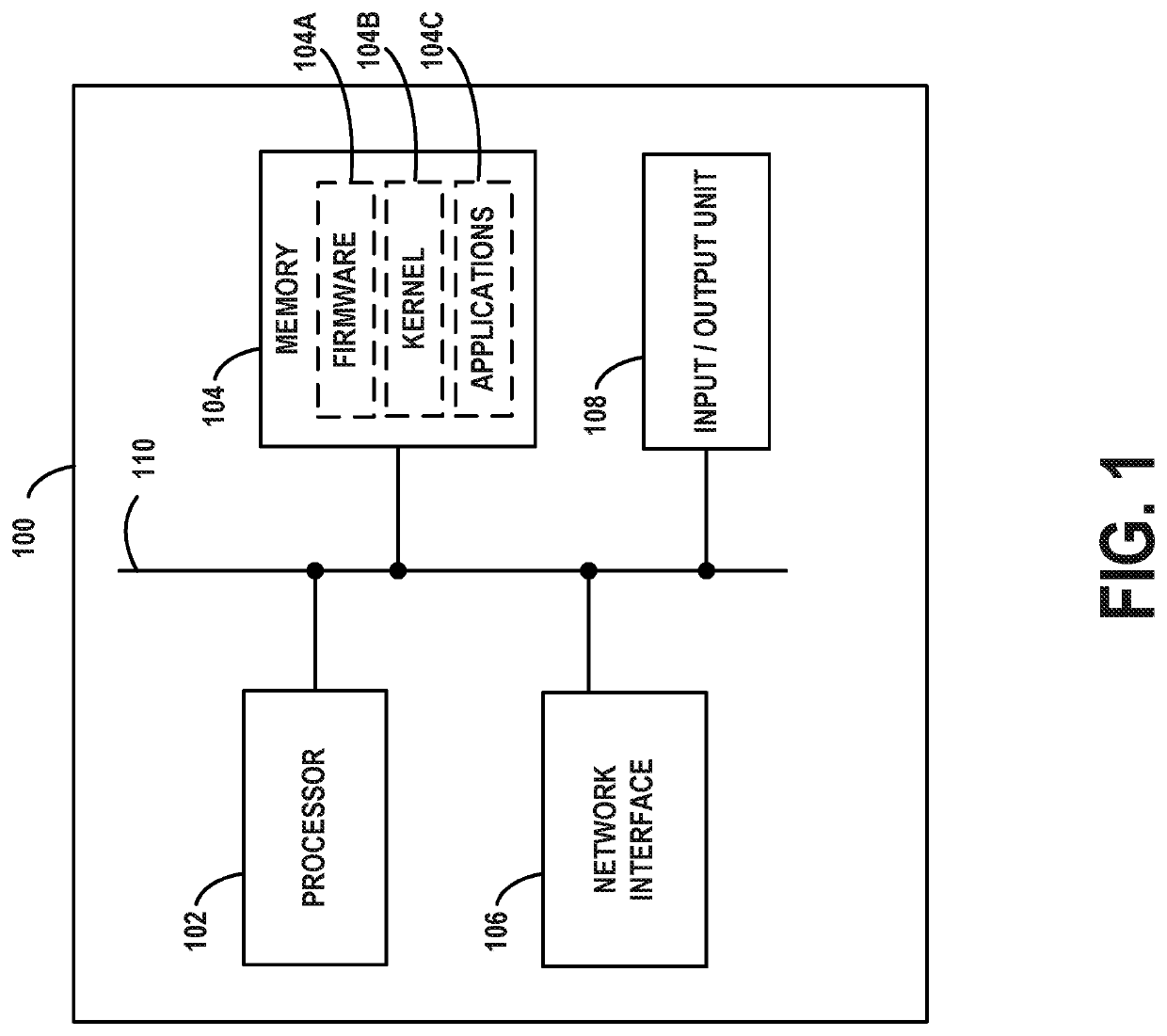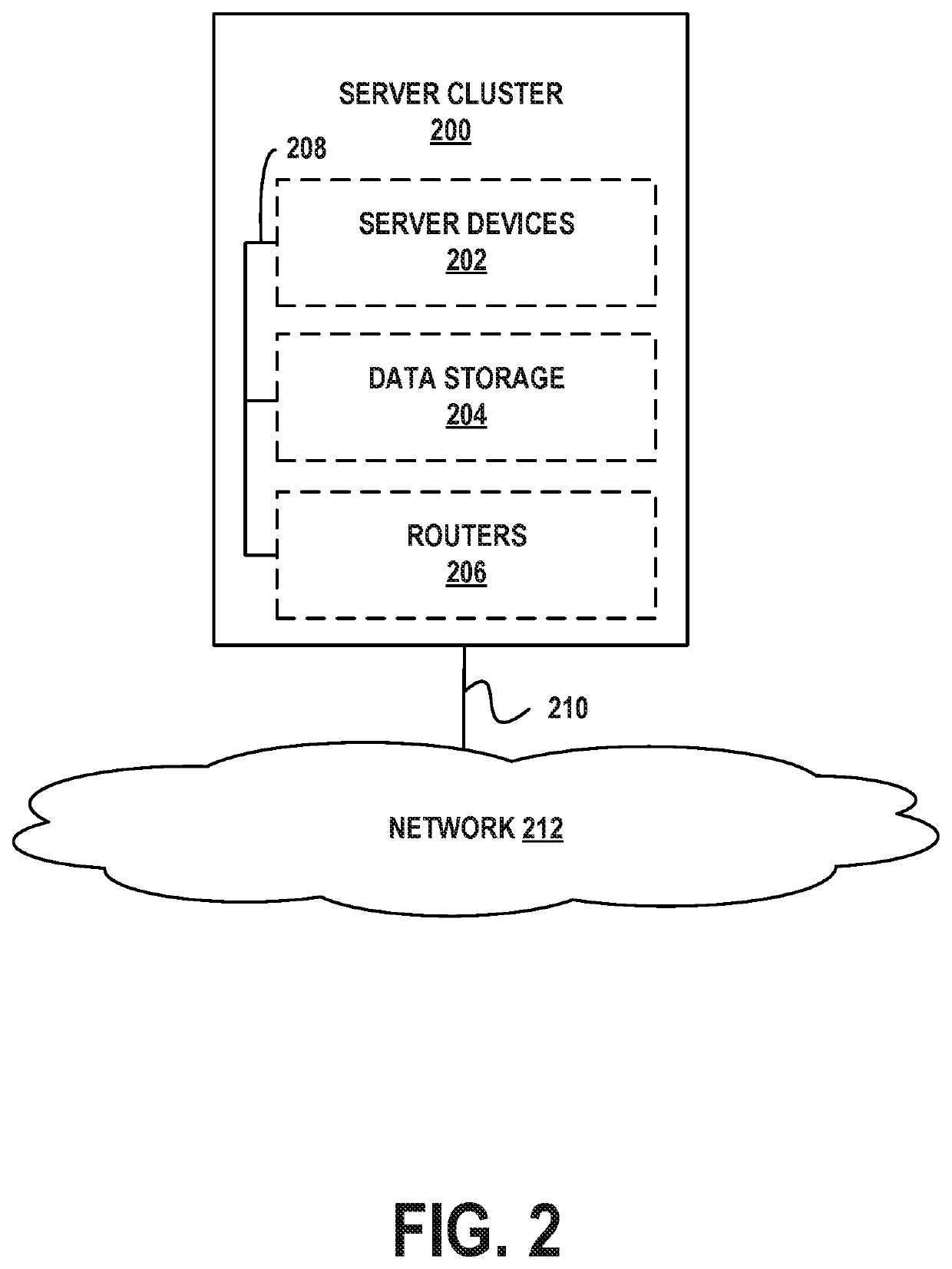[0004]Service mapping creates and maintains maps of computing resources and their dependencies to facilitate analysis of service impacts, help locate outages, and identify other potential issues in a managed network. Among other components, the maps include computing devices, software applications executing thereon, and the dependencies existing therebetween. Conventionally, each software application is developed to be executed in the context of an operating system and computing environment provided by a particular computing device or group thereof. Each software application therefore persists on its corresponding computing device for a prolonged period of time. Service mapping can thus operate with the assumption that once a software application has been detected on a given computing device, it is likely to remain there and its execution is likely to be dependent on successful operation of this computing device.
[0006]However, the increasing popularity of executing software applications in containers calls for a different approach to service mapping than the conventional paradigm of software application execution. A container is a stand-alone executable package of a software application that includes components needed to run the software application, including the software application's code, runtime, system tools, system libraries, and settings, among other components. The container allows the software application to run consistently in different operation environments. Execution of containerized software applications is often facilitated by a containerized orchestration engine such as, for example, KUBERNETES®, which groups containers into units called pods.
[0008]Further, some computing clusters may include a containerized application platform, such as RED HAT® OPENSHIFT®, that is provided alongside the containerized orchestration engine (e.g., may share a namespace with the containerized orchestration engine) to enhance capabilities of the containerized orchestration engine and streamline developer and / or operator interaction with the containerized orchestration engine. For example, the containerized application platform may include multiple solutions and / or workarounds for shortcomings present within the containerized orchestration engine (e.g., security and / or efficiency shortcomings). In addition, the containerized application platform may include software-defined networking and / or other networking solutions that are not present within the containerized orchestration engine. The software-defined networking and / or the networking solutions may enhance an end-user's, a developer's, and / or an operator's accessibility of resources of a computing cluster(s) employed to run the containerized software applications accessible. For example, an operator may be able to use a web console to monitor one or more resources being used to execute a given containerized software application during deployment and / or execution of the containerized software application.
[0010]Still further, the containerized application platform may also enable a streamlined workflow for production, revision, and deployment of containerized software applications. The streamlined workflow may include an image stream that retrieves revised source code images for deployment from an image repository (e.g., a Git repository) and then prepares those revised images for deployment into the computing cluster. Additionally, the containerized application platform may include an automation server (e.g., a Jenkins pipeline). The automation server may allow streamlined deployment from new application code directly to containers. Support for other deployment frameworks, such as service meshes (e.g., Istio) or other middleware (e.g., Knative), may also be included in the containerized application platform.
[0013]Accordingly, a first example embodiment may involve identifying, by a computing device disposed within a remote network management platform, a namespace associated with a containerized orchestration engine. A database may be also disposed within the remote network management platform. The remote network management platform may be associated with a managed network. The managed network may obtain service from a computing cluster that includes one or more worker nodes. The one or more worker nodes may be configured to execute containerized software applications using the containerized orchestration engine. The containerized orchestration engine may facilitate management, execution, and distribution of the containerized software applications across one or more pods hosted on the one or more worker nodes. The first example embodiment may also involve querying, by the computing device, a deployment configuration application programming interface (API) associated with a containerized application platform that shares the namespace with the containerized orchestration engine to obtain deployment configuration data associated with a deployment configuration of the containerized application platform. The containerized application platform may provide tools for deployment and monitoring of the containerized software applications. The deployment configuration may provide a deployment template by which executable images of the containerized software applications are deployed across the one or more pods using a replication controller of the containerized orchestration engine. Further, the first example embodiment may involve querying, by the computing device, a build configuration API associated with the containerized application platform to obtain build configuration data associated with a build configuration of the containerized application platform. The build configuration may provide a build template by which executable images of the containerized software applications are built from source code within the containerized application platform. In addition, the first example embodiment may involve storing, in the database and by the computing device, the deployment configuration data, the build configuration data, and one or more relationships between the deployment configuration data and the build configuration data.
[0017]In a fifth embodiment, a computing system may include a database disposed within a remote network management platform associated with a managed network. The managed network may obtain service from a computing cluster that includes one or more worker nodes. The one or more worker nodes may be configured to execute containerized software applications using a containerized orchestration engine. The containerized orchestration engine may facilitate management, execution, and distribution of the containerized software applications across one or more pods hosted on the one or more worker nodes. The computing system may also include a computing device disposed within the remote network management platform. The computing device may be configured to identify a namespace associated with the containerized orchestration engine. The computing device may also be configured to query a deployment configuration API associated with a containerized application platform that shares the namespace with the containerized orchestration engine to obtain deployment configuration data associated with a deployment configuration of the containerized application platform. The containerized application platform may provide tools for deployment and monitoring of the containerized software applications. The deployment configuration may provide a deployment template by which executable images of the containerized software applications are deployed across the one or more pods using a replication controller of the containerized orchestration engine. The computing device may further be configured to query a build configuration API associated with the containerized application platform to obtain build configuration data associated with a build configuration of the containerized application platform. The build configuration may provide a build template by which executable images of the containerized software applications are built from source code within the containerized application platform. In addition, the computing device may be configured to store, in the database, the deployment configuration data, the build configuration data, and one or more relationships between the deployment configuration data and the build configuration data.
 Login to View More
Login to View More  Login to View More
Login to View More 


